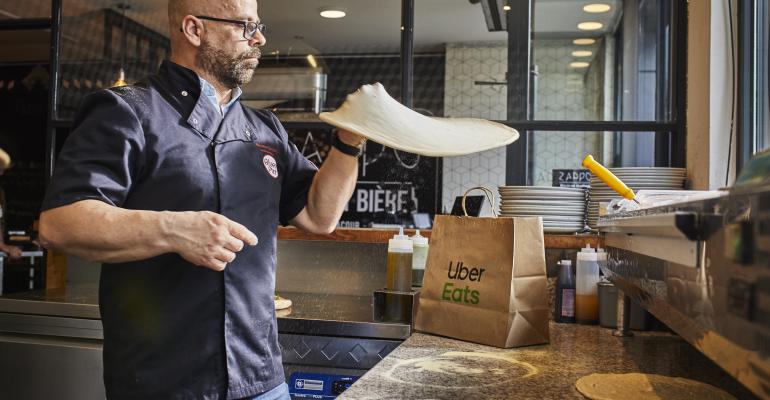Sponsored by Uber Eats
Although food ordering platforms are a hot trend right now, some smaller operators are missing out on the opportunity because they are worried that the costs will cut too deeply into their profits.
Nevertheless, food ordering platforms can be lucrative, if the operator is able to offset the associated expenditures with added sales.
Independent restaurateurs are interested in food ordering platforms, but some are discouraged by the possibility of fees reducing their profits, according to a survey conducted by Uber Eats, the online food ordering platform, and Informa Engage, parent to Nation’s Restaurant News, Restaurant Hospitality and Food Management.
Widespread interest
The survey found that 44 percent of respondents had investigated delivery within the past six months. Price was the most important concern when selecting a delivery platform, 45 percent said. That ranked second after service quality, which was identified by 55 percent of respondents as being most important.
Independent operators have good reason to be cautious about costs, experts say. “The restaurant industry generally is one with extremely tight margins,” says Ilan Shaltuper, senior field account executive for Uber Eats. “There are fixed costs such as rent and labor, and more variable costs like food, which is constantly fluctuating. I think it is something that can be a little scary for restaurants to think about.”
Different packages
With this in mind, Uber Eats offers different packages for independent restaurants and small chains. The basic package, which charges 30-percent commission, includes the high-tech features that restaurants and consumers expect from food ordering platforms. The operator uses the platform to connect with couriers to deliver orders, and the restaurant and customer can look on the app to see where the order is, when it was picked up and what time it will arrive.
The newer package charges a 15-percent commission, which calls for the restaurant to use its own delivery resources. This hybrid version is appealing to restaurants that have their own delivery drivers but do not possess the technological capabilities to build a digital platform. Restaurants of all sizes can benefit from tapping into the marketing expertise of Uber Eats, which can position the establishment’s menu in front of more consumers.
The restaurant will not be able to track their driver because they won’t use the app, Shaltuper says. But for many operators, this version can work for their budget. When deciding whether to partner with a third-party food ordering platform, and which level of service to use, operators should consider the following factors:
• Flexibility
With Uber Eats, operators can employ the 30-percent option or the 15-percent option, or both. “You can toggle back and forth with each,” Shaltuper says. A business might try the 15-percent option and then realize it needs the extra benefits of the 30-percent option, such as the credit-card processing and other tech services.
Not only can operators switch from one platform to another, but in general restaurants also are not required to sign long-term agreements for third-party food ordering platforms. There are no cancelation fees or penalties.
• Outsourcing couriers and marketing
Just as operators outsource payroll or digital media, they can outsource food ordering platforms. One benefit to working with couriers who use the Uber East app is the restaurant does not have to interview drivers and screen them for safe driving records. “We have a full system in place that rates the driver,” Shaltuper says. “If a driver gets bad ratings and hits below a certain ratings level, they would get kicked off the platform. That’s essentially what customers are paying for.”
Operators also benefit from marketing support, as third-party platforms possess vast digital resources. “Because of the branding Uber Eats holds, we can bring more customers to their brand,” he says.
• Labor costs
Operators often balk at the prospect of paying for food ordering platforms, but they can save money by not having to hire people to develop a digital marketing platform. If they opt for the 30-percent commission package, restaurants don’t have to hire drivers and pay the added insurance and other costs. In the current labor environment, anything that saves those costs represents a plus, Shaltuper says.
Also according to the Uber Eats/Informa survey, 52 percent of respondents say delivery comprises 10 percent or more of their business. That suggests that adding food ordering platforms could result in an incremental sales boost. Whether operators are partnering with a third-party platform that handles all the logistics, or easing into the segment by adding a more budget-conscious alternative, they might find that the sales boost helps them compete in a highly competitive marketplace.
For more information, visit www.ubereats.com/restaurant.




